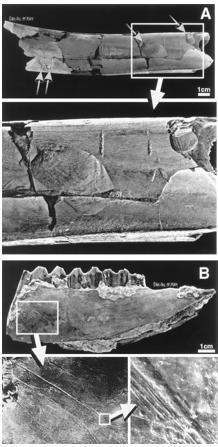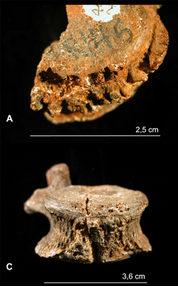Chimpanzees hunt and kill other animals, but it’s insignificant; only making up ~3% of their diet1. It seems seems to be more as a bonding activity than food, because nothing brings friends closer together than murder. Our early ancestors were very similar chimps and seem to have had a similar diet containing not much meat (if any)2. Modern humans, as you may have noticed, tend to eat a bit more meat than this. In fact, many hunter-gatherers are completely reliant on meat for their survival3. At some point over the course of human evolution it seems that meat stopped being just a grisly way of bonding and became a critical source of food. But just when did this happen?
One of the easiest ways to spot when our ancestors began consuming large amounts of meat is to look at the unfortunate animals that fell prey to us. Although the meat itself may have long since decayed their bones remain, sometimes containing cut marks made by stone tools our family produced. In most cases these cut bones are associated with species that looked quite similar to modern humans, such as Homo erectus or Homo habilis, and date to <2 million years ago4. These early humans were hunting large game and transporting it back home where it could be cut up and eaten5.

Some of the bones with tool marks from Bouri
However, the oldest evidence of cut marks on animal bone is actually much older; dating to ~2.6 million years ago. This makes it older than our genus Homo and our more human-like of our ancestors. Bouri, Ethiopia, contains bones with cut marks and the partial skull of Australopithecus garhi; a much more chimp-like member of the human family. Not much about this species is known, but they did have a prognathic face that stuck out like a chimp and a chimp-sized brain. Other members of this genus reveal that they walked upright, like humans, but would have still spend a lot of time swinging through the trees.
Still, Au. garhi is only ~300,000 years older than than the earliest members of Homo; which appear ~2.3 million years go. Is there even older evidence of meat eating? Yes! I learned recently of a particularly interesting skeleton that suggests even earlier members of our family were feasting on the flesh of others. This fossil is slightly older than the stuff from Bouri, dating to ~2.8 million years ago and belongs to Australopithecus africanus; another ape-like member of our family7, except this time from South Africa (the name meaning southern ape of Africa. Scientists not hugely creative when it comes to naming things).
This fossil from Sterkfontein, South Africa, contains several lesions along its spine; consistent with brucellosis. This is a bacterial infection with a range of nasty side effects. The bacteria infects people when *drum roll please* they eat meat or drink milk from an animal infected with the disease6! Milk is an unlikely cause in this case since our family only began consuming the milk of other animals after they were domesticated, something which didn’t happen until ~10,000 years ago7 (making it slightly younger than 2.8 million years ago); so it looks like this unfortunate Australopithecus ate some tainted meat. Unlucky for him, very luck for us.

The vertebra of the Austrlaopithecus africanus with lesions
Now with only one case of brucellosis we can’t really say how widespread it was. It may well be that Au. africanus was eating meat as often as chimps do; and this individual got unlucky on one of their bi-weekly fun family murder-athons. And at only 2.8 million years old it isn’t that much older than the Gona specimens. Indeed, on its own this fossil is interesting but not that spectacular. But it does show that Australopithecus africanus may have eaten meat; and once you consider this possibility a lot of circumstantial evidence begins to slot into place.
Isotope analysis is based around the idea that you are what you eat. Slightly different variants of elements (known as isotopes) accumulate in different places. Then when you eat them, they accumulate in your body. So by looking at the bones of fossils, we can examine their isotopes to see what they were eating.
Examining the Carbon isotopes found in Australopithecus africanus reveals they were a highly opportunistic; eating a broad range of food. They were beginning to expand out of the forest onto the Savannah, and we see increasing evidence that they were getting a large portion of the food from this environment. In particular they seem to have been eating grasses and sedges (plants that are enriched with an isotope of Carbon known as C13)8. However, to identify whether they were eating meat we really need to look at isotopes of nitrogen, which sadly aren’t preserved.. As such…
Stable carbon isotope analysis of A. africanus….demonstrates that this early hominid ate not only fruits and leaves but also large quantities of carbon-13–enriched foods such as grasses and sedges or animals that ate these plants, or both8.
To make things even more interesting, when the teeth of Australopithecus africanus were examined it was found the damage on them was inconsistent with the meat-rare diet of chimps and baboons, a primate which lives off these grasses and sedges. The fossils being examined here date back to >3 million years ago8! Could it be that our family was eating meat all this time ago?
As I said, this is circumstantial evidence; the isotope analysis being consistent with them just eating plants after all and the teeth are unlike baboons and chimps, not similar to a carnivores. But we do know that at least one member of the species ate some meat (and was unlucky enough to get bacteria out of it). Whether it was more widespread is something we can’t say without more evidence; but it is a tantalizing possibility. The idea that our ape-like ancestors were higher up in the food chain, scary enough to pinch food from other carnivores (or even hunt for themselves) is one I really like.
Hopefully future studies find more evidence for it; and if they do I will be screaming about it from the hills. In the meantime a moment of silence for the unfortunate hominin who tried to get a tasty snack of meat one day and wound up changing our understanding of human evolution.
References
- McGrew, W. C. (1983). Animal foods in the diets of wild chimpanzees (Pan troglodytes): Why cross-cultural variation?. Journal of Ethology, 1(1-2), 46-61.
- Suwa, G., Kono, R. T., Simpson, S. W., Asfaw, B., Lovejoy, C. O., & White, T. D. (2009). Paleobiological implications of the Ardipithecus ramidus dentition.Science, 326(5949), 69-99.
- Boyd and Silk, 2012. How Humans Evolved. 6th ed. London: W. W. Norton & Company
- Braun, D. R., Harris, J. W., Levin, N. E., McCoy, J. T., Herries, A. I., Bamford, M. K., … & Kibunjia, M. (2010). Early hominin diet included diverse terrestrial and aquatic animals 1.95 Ma in East Turkana, Kenya. Proceedings of the National Academy of Sciences, 107(22), 10002-10007.
- Bunn, H. T. (1986). Patterns of skeletal representation and hominid subsistence activities at Olduvai Gorge, Tanzania, and Koobi Fora, Kenya. Journal of Human Evolution, 15(8), 673-690.
- D’Anastasio R, Zipfel B, Moggi-Cecchi J, Stanyon R, Capasso L (2009) Possible Brucellosis in an Early Hominin Skeleton from Sterkfontein, South Africa. PLoS ONE 4(7): e6439. doi:10.1371/journal.pone.0006439
- Evershed, R. P., Payne, S., Sherratt, A. G., Copley, M. S., Coolidge, J., Urem-Kotsu, D., … & Burton, M. M. (2008). Earliest date for milk use in the Near East and southeastern Europe linked to cattle herding. Nature, 455(7212), 528-531.
- Sponheimer, M., & Lee-Thorp, J. A. (1999). Isotopic evidence for the diet of an early hominid, Australopithecus africanus. Science, 283(5400), 368-370.

